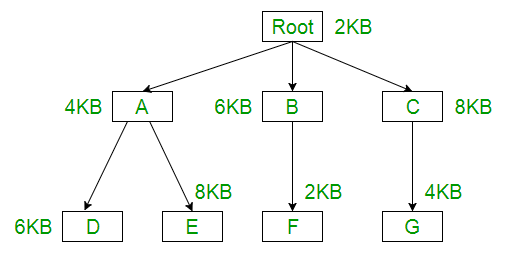Overlays in Memory Management
Last Updated :
12 Feb, 2023
In memory management, overlays refer to a technique used to manage memory efficiently by overlaying a portion of memory with another program or data.
The idea behind overlays is to only load the necessary parts of a program into memory at a given time, freeing up memory for other tasks. The unused portions of the program are kept on disk or other storage, and are loaded into memory as needed. This allows programs to be larger than the available memory, but still run smoothly.
The main problem in Fixed partitioning is the size of a process has to be limited by the maximum size of the partition, which means a process can never be span over another.In order to solve this problem, earlier people have used some solution which is called as Overlays.
The concept of overlays is that whenever a process is running it will not use the complete program at the same time, it will use only some part of it. Then overlays concept says that whatever part you required, you load it and once the part is done, then you just unload it, means just pull it back and get the new part you required and run it.
Formally,
“The process of transferring a block of program code or other data into internal memory, replacing what is already stored”.
Sometimes it happens that compare to the size of the biggest partition, the size of the program will be even more, then, in that case, you should go with overlays.
So overlay is a technique to run a program that is bigger than the size of the physical memory by keeping only those instructions and data that are needed at any given time.Divide the program into modules in such a way that not all modules need to be in the memory at the same time.
Advantages of using overlays include:
- Increased memory utilization: Overlays allow multiple programs to share the same physical memory space, increasing memory utilization and reducing the need for additional memory.
- Reduced load time: Only the necessary parts of a program are loaded into memory, reducing load time and increasing performance.
- Improved reliability: Overlays reduce the risk of memory overflow, which can cause crashes or data loss.
- Reduce memory requirement
- Reduce time requirement
Disadvantages of using overlays include:
- Complexity: Overlays can be complex to implement and manage, especially for large programs.
- Performance overhead: The process of loading and unloading overlays can result in increased CPU and disk usage, which can slow down performance.
- Compatibility issues: Overlays may not work on all hardware and software configurations, making it difficult to ensure compatibility across different systems.
- Overlap map must be specified by programmer
- Programmer must know memory requirement
- Overlapped module must be completely disjoint
- Programming design of overlays structure is complex and not possible in all cases
Example –
The best example of overlays is assembler. Consider the assembler has 2 passes, 2 pass means at any time it will be doing only one thing, either the 1st pass or the 2nd pass. This means it will finish 1st pass first and then 2nd pass.Let assume that available main memory size is 150KB and total code size is 200KB
Pass 1.......................70KB
Pass 2.......................80KB
Symbol table.................30KB
Common routine...............20KB
As the total code size is 200KB and main memory size is 150KB, it is not possible to use 2 passes together.So, in this case, we should go with the overlays technique.According to the overlays concept at any time only one pass will be used and both the passes always need symbol table and common routine.Now the question is if overlays-driver* is 10KB, then what is the minimum partition size required?For pass 1 total memory needed is = (70KB + 30KB + 20KB + 10KB) = 130KB and for pass 2 total memory needed is = (80KB + 30KB + 20KB + 10KB) = 140KB.So if we have minimum 140KB size partition then we can run this code very easily.
*Overlays driver:-It is the user responsibility to take care of overlaying, the operating system will not provide anything.Which means the user should write even what part is required in the 1st pass and once the 1st pass is over, the user should write the code to pull out the pass 1 and load the pass 2.That is what is the responsibility of the user, that is known as the Overlays driver.Overlays driver will just help us to move out and move in the various part of the code.
Question –
The overlay tree for a program is as shown below:

What will be the size of the partition (in physical memory) required to load (and
run) this program?
(a) 12 KB (b) 14 KB (c) 10 KB (d) 8 KB
Explanation –
Using the overlay concept we need not actually have the entire program inside the main memory.Only we need to have the part which are required at that instance of time, either we need Root-A-D or Root-A-E or Root-B-F or Root-C-G part.
Root+A+D = 2KB + 4KB + 6KB = 12KB
Root+A+E = 2KB + 4KB + 8KB = 14KB
Root+B+F = 2KB + 6KB + 2KB = 10KB
Root+C+G = 2KB + 8KB + 4KB = 14KB
So if we have 14KB size of partition then we can run any of them.
Answer -(b) 14KB
Like Article
Suggest improvement
Share your thoughts in the comments
Please Login to comment...